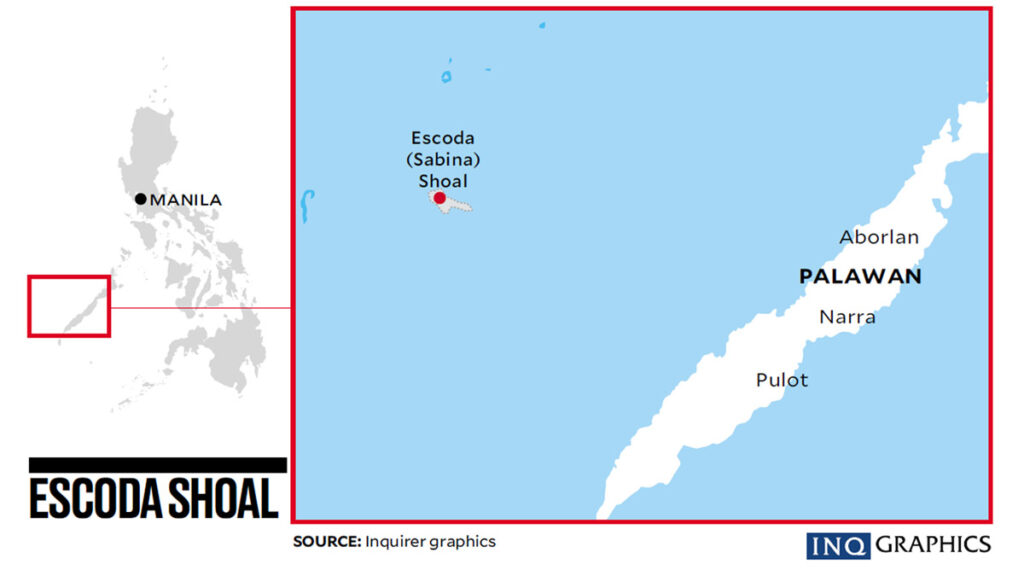
FILE PHOTO: In the West Philippine Sea, the China Coast Guard’s (CCG) “monster ship” has been inching closer to the Philippine Coast Guard’s (PCG) vessel at Escoda (Sabina) Shoal. INQUIRER FILES
MANILA, Philippines — The China “monster ship” has been inching closer to the Philippine Coast Guard’s (PCG) vessel at Escoda (Sabina) Shoal in the West Philippine Sea.
According to PCG spokesperson for the West Philippine Sea Commodore Jay Tarriela, the enormous CCG ship is only about 500 yards away from PCG’s biggest vessel as of Friday morning. Previously, the CCG ship with hull number 5901 was spotted about 0.5 nautical miles, or around 1,012 yards, away from the PCG’s BRP Teresa Magbanua (hull number 9701).
The PCG’s BRP Teresa Magbanua is officially the longest-ever deployed Philippine asset in the West Philippine Sea.
Tarriela said personnel of the BRP Teresa Magbanua relentlessly issued radio challenges to the CCG ship but it continued to sail.
READ:
PCG challenges China’s ‘monster ship’ anchored off Escoda Shoal
West Philippine Sea: Navy’s June 17 encounter with CCG incurs P60M damage
West Philippine Sea deal with China denied by Duterte
The CCG’s gigantic patrol cutter, the largest coast guard vessel in the world, departed off Hainan Island waters on July 1 and arrived near Ayungin (Second Thomas) Shoal on July 3.
It even approached Mischief Reef before heading to Escoda Shoal also on July 3.
“Since the day of its arrival [in Escoda Shoal] troops aboard the 9701 challenged the ship,” Tarriela told reporters in an interview Friday, July 4.
The PCG deployed BRP Teresa Magbanua on April 16 as it suspected reclamation in Escoda Shoal, which falls 75 nautical miles from the coast of Palawan or well within the Philippines’ exclusive economic zone.
“This is the longest deployment of coast guard in the West Philippine Sea because it already reached more than two months,” Tarriela noted.
Escoda Shoal serves as the rendezvous point for Filipino vessels involved in resupply missions to naval troops stationed at BRP Sierra Madre, which was grounded in nearby Ayungin Shoal.
On June 17, CCG personnel rammed, towed, and even boarded Philippine Navy boats during the resupply mission to BRP Sierra Madre, which the Philippine military said led to what they deem as “looting” and even caused serious injuries to one of its naval personnel.
Manila and Beijing held its regular Bilateral Consultation Mechanism on Tuesday, July 2, to tackle deescalation after the violent June 17 incident, according to the Department of Foreign Affairs.
Beijing’s deployment of “monster ship” off Ayungin Shoal – seen as the main flashpoint of tensions in the West Philippine Sea – the day after its talks with Manila did not escape the attention of SeaLight director Ray Powell.
“China aims to force the Philippines to negotiate from a position of relative weakness in hopes of extracting concessions in exchange for de-escalation,” Powell, program head of Stanford University’s Gordian Knot Center for National Security Innovation which monitors Chinese vessels activity in South China Sea, told INQUIRER.net on Wednesday.
Beijing asserts sovereignty in almost the entire South China Sea, including most of the West Philippine Sea, even if such a claim has been effectively invalidated by an arbitral award issued in July 2016.
The landmark ruling stemmed from a case filed by Manila in 2013, or a year after its tense standoff with Beijing over Panatag (Scarborough) Shoal, which lagoon is now being controlled by China. — With reports from Felice Nafarrete, trainee

